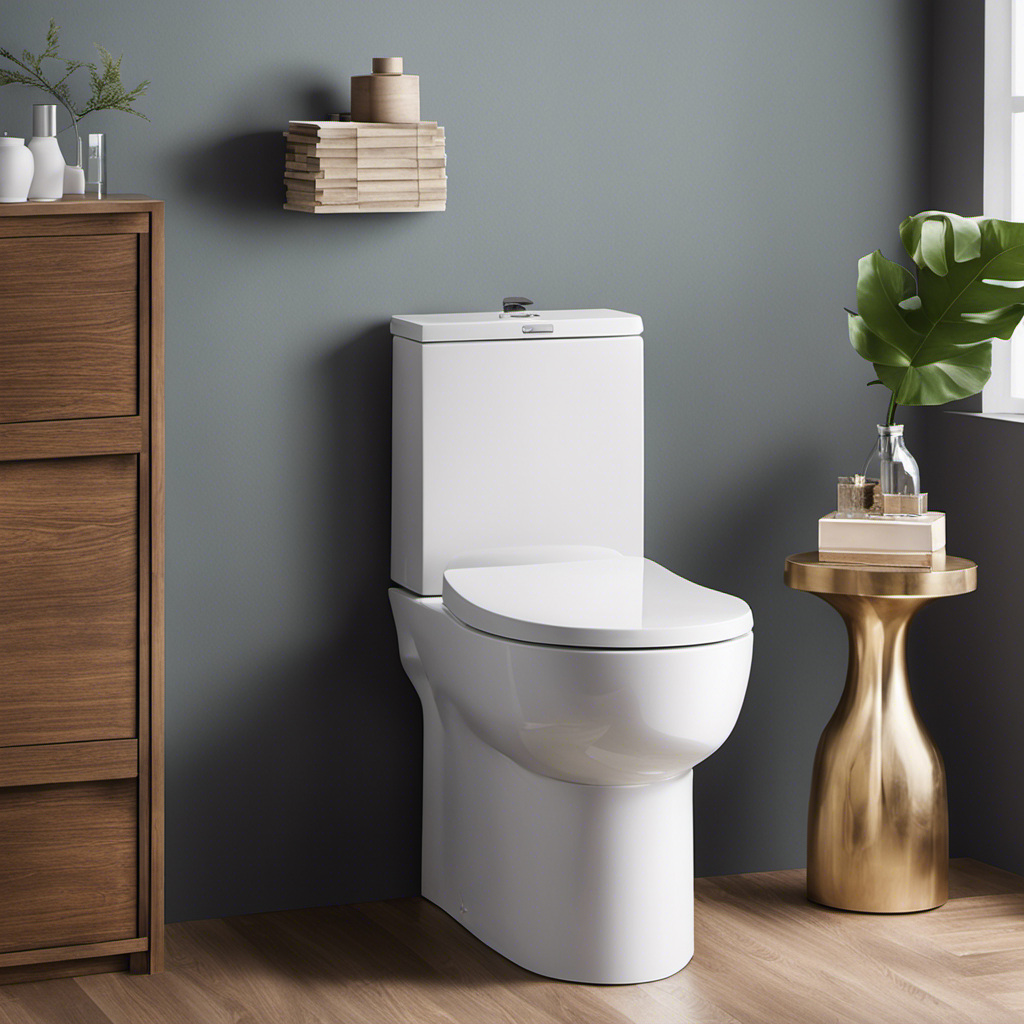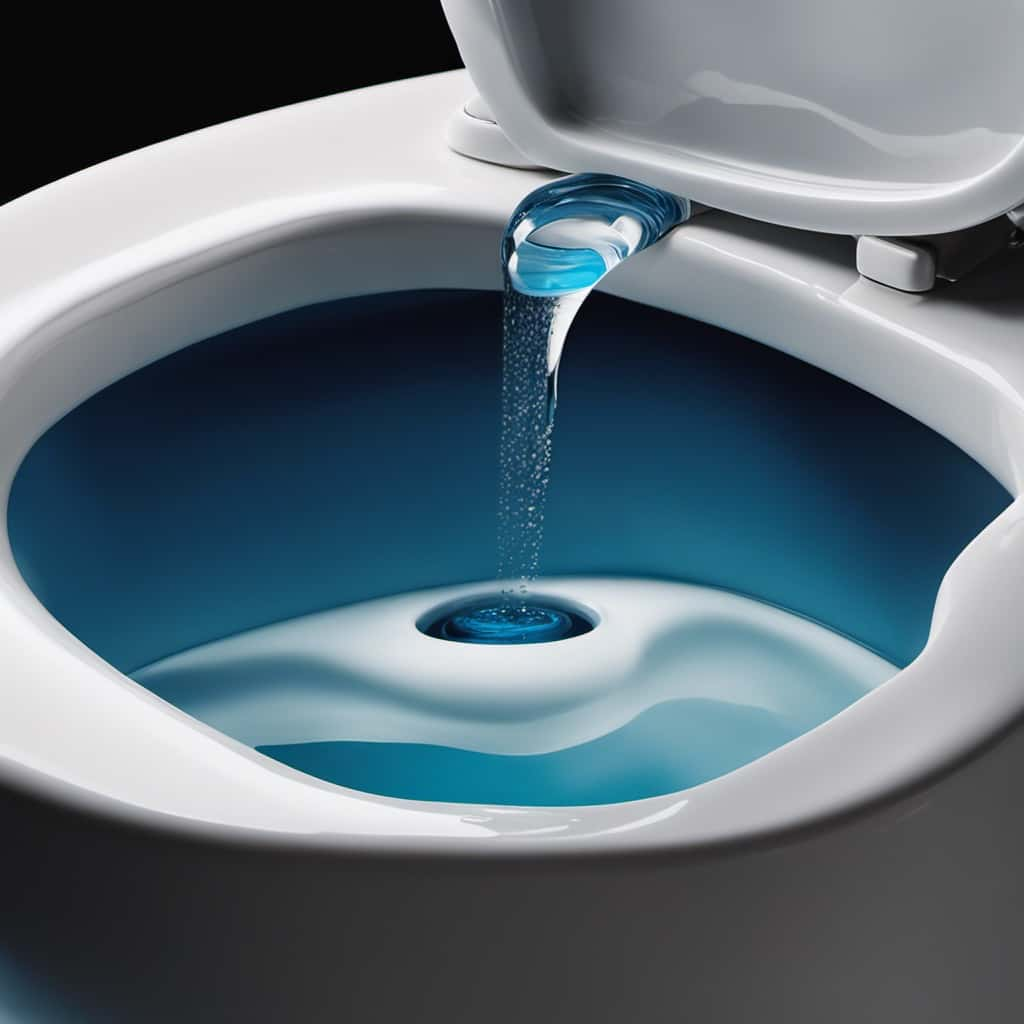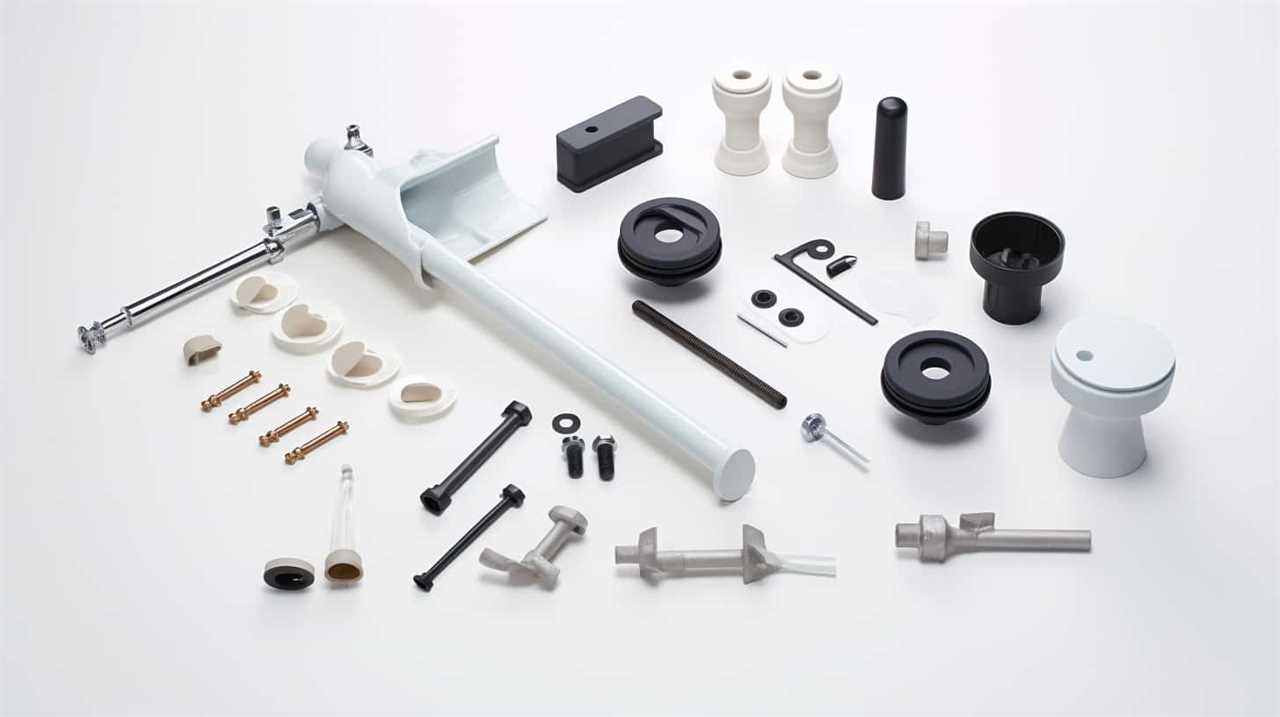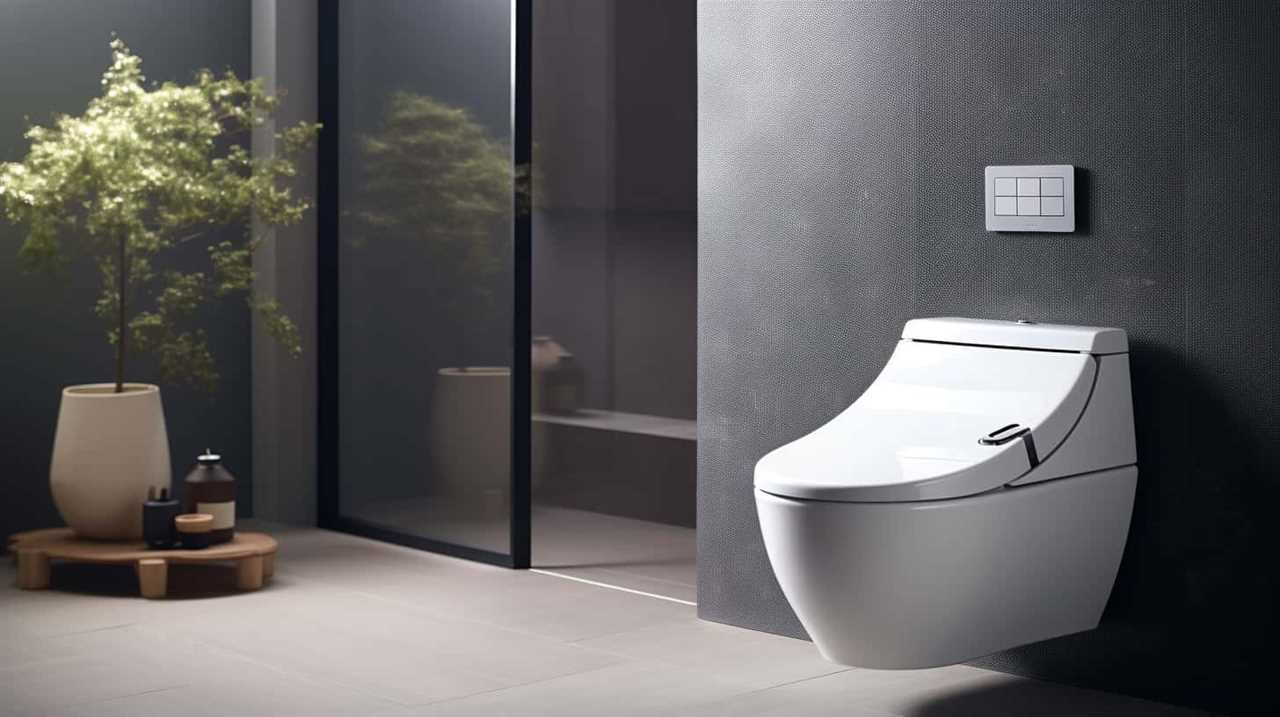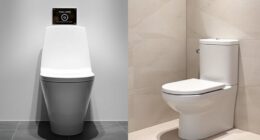When it comes to finding the perfect toilet, it’s not as easy as you might think. There are a lot of factors to consider, and each one plays a crucial role in determining the overall functionality and aesthetic of your bathroom.
From the rough-in size to the flushing strength, water usage, and design, every detail matters. Trust me, I’ve done my research.
So, let me guide you through the ins and outs of choosing the ideal toilet that meets all your needs.
Key Takeaways
- The rough-in size of a toilet, which is the distance between the wall and the center of the drainpipe, is an important consideration when choosing a toilet.
- Checking the flushing strength, such as MaP scores, is crucial to ensure good suction and prevent future clogs.
- Water usage is an important factor to consider, with eco-friendly models using less water and potentially saving on water bills.
- The exterior design of the toilet, including whether it is one-piece or two-piece and the style of the trapway, can contribute to the overall look of the bathroom.
Importance of Rough-In Size
I need to measure the rough-in size to ensure the toilet will fit in my bathroom space. Measuring the rough-in accurately is crucial when choosing the right rough-in for your bathroom.
The rough-in size refers to the distance between the wall and the center of the toilet’s drainpipe. The most common rough-in size is 12 inches, but 10 inch and 14 inch rough-ins are also available.
To measure the rough-in, you need to measure from the water outlet beneath the toilet to the wall facing the back of the toilet. Smaller spaces require smaller rough-in sizes, such as 10 rough-ins, while larger spaces use bigger rough-ins, like 14 rough-ins.
Understanding Flushing Strength
Researching different brands’ flushing mechanisms helps me understand the various strengths of the flush. When it comes to toilet flush technology, measuring flushing power is crucial in choosing the perfect toilet. Here are four key points to consider:
-
Flushing Mechanisms: Different brands employ different technologies to achieve powerful flushes. Understanding how these mechanisms work can help determine the flushing strength of a toilet.
-
MaP Scores: MaP scores provide a standardized way to measure flushing performance. Higher scores indicate stronger flushing power, ensuring efficient waste removal and preventing clogs.
-
Suction Strength: Good suction strength is essential for a powerful flush. This prevents clogs and ensures thorough waste removal, promoting cleanliness and reducing maintenance.
-
Consideration in Selection: When choosing a toilet, flushing strength should be a significant factor. A toilet with a strong flush will provide peace of mind and reliable performance.
Considerations for Water Usage
Considering the environmental impact, opting for a toilet with lower water consumption can be a more sustainable and cost-effective choice. Low flow toilets offer several benefits in terms of water usage. When comparing water usage between different toilet models, it is important to look at the gallons per flush (gpf) rating.
The maximum water usage per flush, as per EPA guidelines, is 1.6 gpf. However, eco-friendly models typically use 1.28 gpf, which can save up to 20% in water usage. Some dual-flush models even have lower options, using only 0.8 to 1 gpf.
Exploring Exterior Design Options
When exploring toilet options, it’s important to think about whether you prefer a one-piece or two-piece design. Here are some key considerations for the exterior design of a toilet:
-
Toilet Color Options: Choose a color that complements your bathroom decor and personal style. Popular options include white, black, and various shades of gray.
-
Benefits of a Skirted Trapway: A skirted trapway is a sleek and modern design that hides the trapway, making it easier to clean and giving the toilet a streamlined appearance. It also eliminates the nooks and crannies where dirt and bacteria can accumulate.
-
One-Piece vs Two-Piece: One-piece toilets have a seamless design, making them easier to clean and less likely to break during transportation. Two-piece toilets are more traditional and often more affordable, with a separate tank and bowl.
-
Overall Aesthetic: Consider the overall look you want to achieve in your bathroom. A one-piece toilet with a skirted trapway can give a contemporary and sophisticated feel, while a two-piece toilet may be more suitable for a classic or traditional style.
Factors to Consider When Choosing a Toilet
I need to evaluate the available options to ensure the toilet I select fits my bathroom space. When considering installation requirements, it is crucial to measure the rough-in size, which is the distance between the bathroom wall and the center of the toilet’s drainpipe.
The most common rough-in size is 12 inches, but 10 inch and 14 inch rough-ins are also available.
Additionally, maintenance and cleaning are important factors to consider. One-piece toilets are easier to clean and less likely to break in transit. They also do not require drill holes to support their water tank. Regular cleaning is necessary to maintain hygiene and prevent the buildup of bacteria and stains.
Overall, assessing installation requirements and considering maintenance and cleaning needs are key factors in choosing the perfect toilet for my bathroom space.
Maximizing Efficiency: Rough-In, Flushing, and Water Usage
Measuring the rough-in size is crucial to ensure the toilet fits properly in the bathroom space. It is important to measure accurately to avoid installation problems.
Here are some key points to consider when measuring the rough-in size:
-
Use a tape measure: To determine the rough-in size, measure from the wall to the center of the toilet’s drainpipe. Be precise in your measurements for accuracy.
-
Account for baseboard and molding: If there are baseboards or moldings in the bathroom, include their measurements in your calculations. This will give you a more accurate rough-in size.
-
Consider water conservation: Opt for a toilet with a smaller rough-in size to contribute to water conservation efforts. Choosing a toilet with a 10-inch or 14-inch rough-in can minimize water usage without compromising performance.
-
Seek professional help if unsure: If you are unsure about measuring accuracy or selecting the right rough-in size, consult a professional plumber. They can provide expert guidance and ensure your toilet fits perfectly in your bathroom space while maximizing water conservation efforts.
Enhancing Bathroom Aesthetics: Design Considerations
The exterior design of a toilet greatly impacts the overall aesthetic of the bathroom. When selecting a toilet, it is important to consider the design elements that will complement your bathroom decor. One aspect to consider is the color options available for toilets. Many manufacturers offer a range of colors to choose from, allowing you to match your toilet to the rest of your bathroom fixtures. Additionally, selecting the right seat is crucial for both comfort and style. There are various seat materials to choose from, such as plastic, wood, or cushioned seats. It is also important to consider the shape and size of the seat, ensuring it fits properly on the toilet bowl. By paying attention to these design details, you can create a cohesive and visually appealing bathroom space.
| Design Consideration | Description |
|---|---|
| Color Options | Choose from a range of colors to match your bathroom decor |
| Selecting the Right Seat | Consider materials, shape, and size for comfort and style |
Frequently Asked Questions
Can I Use a Toilet With a 14-Inch Rough-In in a Small Bathroom?
Yes, a toilet with a 14-inch rough-in can be used in a small bathroom. However, if space is limited, there are alternative toilet options with smaller rough-ins, such as 10 or 12 inches.
How Can I Determine the Flushing Strength of a Toilet?
To determine the flushing strength of a toilet, I would check the toilet bowl‘s design and the water pressure. The shape and size of the bowl and the force of the water flow contribute to the flushing strength of a toilet.
Are There Any Toilets That Use Less Than 0.8 Gpf?
Yes, there are toilets that use less than 0.8 gpf. These toilets are considered alternatives to traditional toilets and are designed to have low water consumption, making them eco-friendly and cost-effective.
What Is the Difference Between a Skirted and Exposed Trapway?
A skirted trapway is concealed, making it easier to clean, while an exposed trapway is visible and may require more maintenance. Both options have their pros and cons when it comes to toilet installation and maintenance.
Are There Any Disadvantages to Using a One-Piece Toilet?
There aren’t any disadvantages to using a one-piece toilet. It has advantages like easier maintenance and no need for drill holes. It’s a great choice for a modern bathroom design.
